I wanted to do another post about making sourdough bread. Since my first How To Make Sourdough post and the Update, I’ve learnt quite a lot and continue to do so.
I’ve now got more experience handling different flours and doughs. I’ve tried different ways of developing the dough, folding, kneading and no-knead.
What I now have is a method that I’m pretty happy with and which produces a consistently good loaf for our daily bread. It’s a bit different from what I used to do. I’ve been asked quite a lot now for my normal method which I’ve emailed to people. One email recipient, Carla Tomasi, suggested that the method would make a useful blog post and encouraged me to sort it out. So here it is.
Before I start, just to say this post will just cover the ingredients and method. I’ll leave the explanations to another post for those that are interested. So if you wanted to print this off, there will not be loads of extraneous information. I hope that’s ok.
Want to have a go? Read on…
How to make sourdough bread recipe
This quantity makes two loaves. The amount of water is not so high that the dough is impossible to handle. It will start sticky and improve as the dough ‘develops’. So please don’t add lots more flour. You’ll find it much better to work with wet hands or to oil your hands and the work surface.
Ingredients
200g active starter (made with equal weights of flour and water) See here for how to make a starter.
625g warm water
900g strong white flour
100g spelt or strong wholemeal flour (or you can just use all white)
20g sea salt, finely ground
Method
Put the starter and water in a bowl and mix. Add the flour and mix until all the grains of flour are wet. I use a dough scraper to help me do this.
A big spoon or your hands will both work well.
You should now have a sticky, shaggy mass.
Leave for 20-30 minutes.
Add the salt and mix well so the salt is well distributed.
Cover with oiled plastic and leave for 1hr.
Fold the dough like this video.
This is your first fold.
Cover with oiled plastic and leave for 1hr.
Fold again for your second fold. Cover with oiled plastic and leave for 1hr.
Fold again for your third fold. Cover with oiled plastic and leave for 1hr.
During the folding, the dough should change in feel from a shaggy mass, to putty like, to a resilient and elastic feel. You should be able to see and feel bubbles in it. If, after some practice, you feel it’s not getting strong enough as you go through, give it some more folds on one or more goes. Eventually you’ll not be able to fold the dough and so it tells you when it’s had enough.
Then divide the dough in two and roughly pat out into a rectangle, round or oval depending on what you want the final shape of the loaf to be: long, round or batard.
Leave for 30 minutes covered in oiled plastic.
Make the dough into your final shapes and put into proving baskets/bannetons or onto baking parchment and cover with oiled plastic and a tea towel. If you’re using proving baskets/bannetons make sure that they and the tops of the loaves are well floured with either rye or rice flour. Using these flours will help make sure your dough does not stick. Normal flour tends to absorb more water and is much more likely to stick.
Here’s how I shape a round boule and use a banneton.
Allow to prove for 1½ to 4 hours. This time really will depend on the temperature. What you are looking for is for the gases produced by the fermenting yeast to still have some power. When the loaf is first made, the dough is very resilient. If you press it with a finger it will push back and fill the dent. The longer you prove the less pronounced this effect is. Ideally, you will pop the loaf in the oven before the dough ceases to push back. You’ll learn to judge the timing the more you bake. It’s worth saying that with sourdough you will not get the dramatic ‘doubling in size’ you see in some other yeasted bread recipes. Look for a 25-50% increase
About 45-60 minutes before you bake, preheat your oven to highest setting. When you first start, judging this time won’t be easy so err on the side of being early rather than late. Starting your loaf off in an oven that is not hot enough will not get you good results.
I bake on a granite stone which gives good heat to the bottom of the loaves and a good crust and rise. You can use ceramic tiles, pizza stones or preheated oven trays for a similar effect.
If possible put a tray of boiling water on lowest tray below where bread will bake 10-15 mins beore you start baking to create steam.
Here’s how I set my oven up with the granite stone above a shelf on which I put a wide oven tray containing some boiling water.
Do be careful as you transfer the tray to the oven.
When loaves are proved, slash the tops and pop in them in the oven and turn it to 230°C. Bake for 15 minutes.
During this time the loaf should rise appreciably.
Then take out the water tray and turn down the heat to 200°C and bake for another 30 minutes or so until you are happy it’s baked right through. I tend to bake my loaves for 50-55 minutes so the crust is good and crackles when it comes out of the oven. If you don’t like such a robust crust, then you can cook the bread for 40 minutes or so.
Take the bread out of the oven and allow to cool on a rack. If you like crust, then leave it uncovered until it’s cool. I f not, you can put a clean tea towel over the bread and this will ensure a softer crust.
That’s all there is to it.
Kamut sourdough loaf
Finally, I promised in this post about the Kamut loaf to say how I made it.
The only variation to the above recipe was as follows:
I used 800g strong white flour and 200g of kamut flour.
The higher percentage of non-white flour and the fact that it absorbs more water meant I increased the water to 640g.
Everything else is precisely as the recipe above. Here’s the crust and crumb of the loaf.
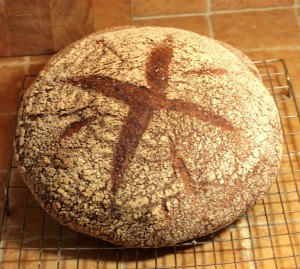
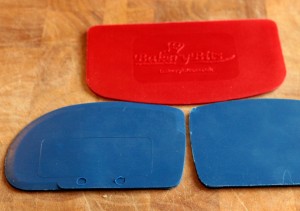
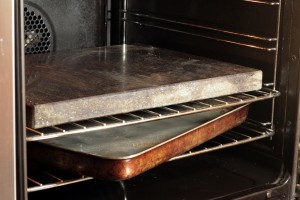
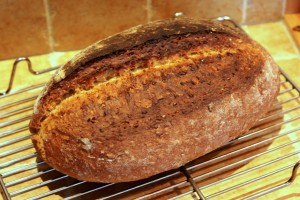
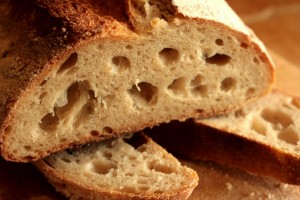
Comments
19 responses to “How to make sourdough bread simply”
[…] Jessica left the dough to bulk prove and gave a stretch and fold. See the first video in my how to make sourdough post. […]
This is such a great blog!!! Really makes me hungry just reading and looking at the pictures : ) I recently baked my first loaf of bread and it was incredible!!! I used a starter my friend told me about. It’s from Sourdough’s International and now I have to spread the word! I loved it. Definitely going to order more when it comes the time.
[…] allow it to prove for 45 minutes after the second fold. To see how to fold watch the video on my How to make Sourdough Simply post. So it’s mix, leave 45 minutes, fold twice as per the video, leave 45 minutes, fold twice, […]
[…] How to make sourdough bread simply […]
Hi Carl,
I hope you’re enjoying your autumn! Quick question for you, or at least I hope it might be. I’ve got a good starter that I’ve been using that’s based entirely on rye flour. It makes a mighty sour loaf. Is there any way of toning down the sour flavour in the bread? I’m not sure if different starter flours give different levels of sourness?
Thanks!
Harmony
Hi Harmony, so sorry to come to this so late. You can tone down the sour flavour by using less of the ‘old’ starter when you refresh, by giving the starter less time to ferment, or by using less water and making a thicker starter. Different flours ‘feed’ the bacteria and yeasts in different ways and take different metabolic pathways to produce the lacti and acetic acids.
I tend to use rye as a component to get the starter off to a quick go. Try different flours and experiment with the variables I suggest above and you’ll begin to get a feel and undertanding of what influences what. If you need a more detailed explanantion then head over to Azelias Kitchen blog – Az has some really detailed stuff on the anatomy of a starter there 🙂
My first attempt has been baked and eaten today Carl and it was a resounding success, in fact, so much so that It was eaten too quickly to get photos. We even went to visit our local mill to get more flour. Will have to make more very soon, I even managed on my own with folding much easier than kneading for an MS sufferer with co-ordination problems. Thanks for inspiring me to try it. A. xx
Hi Anna, it’s brilliant to hear from you 🙂
I’m so pleased you had a good result with the sourdough and that everyone enjoyed it.
When you next have a go, I’d love to see some pictures if you can manage to hold on that long 😀
The folding method is a real boon for those of us that the full-on kneading technique doesn’t suit. So glad it’s enabled you to make bread you love to eat.
I appreciate your kind words, it’s events like your bread that this blog is written for. So thank to you for letting me know.
Carl x
Hi,
This looks great and very easy. Can you confirm that there is no kneading at all for the sourdough loaf? only the folding? Thanks
Hi Harmony, yes I can confirm that. No kneading required at all, just folding. Hope you have a go at it, let me know if you do 🙂
Hi Carl,
Yes, I gave it a try but changed the proportions slightly (added more water since was using a combination of spelt and kamut and whole grain flour and it seemed a bit dry). But I got a little carried away and in the end the dough was so soft it made a focaccia! But it was still nice. I’ll try again this weekend. Thanks for the advice and instructions. This is a great website.
Hi Harmony, well done for giving it a go. You now have some useful feedback to store away for the future. I often reccomend that people start with just a basic white sourdough just so they can get the feel of ‘normal’ to compare to later when changing flours and water content. Let me know how the nxt one goes, it’s exciting 🙂
Hi Carl,
I think it’s all coming together now…made 2 loaves last week, one in a tin and one as a round. A mix of white and spelt for the one, and white and kamut for the other. Delicious! My partner and I can’t believe that we’ve been making bread with dry yeast for all this time when a loaf with sourdough starter is superior in pretty much all respects – easier, nicer texture, and you don’t have to buy yeast.
I’m not sure if you watched the Hairy Bikers Bake-ation show when they were in Norway (broadcast about 3 weeks ago and now available on iPlayer), but they visited an incredible bakery and made a lovely sourdough there that you might be interested in. Unfortunately the recipe is not on the website, but I wrote to the bakery and they said they were going to make it available on the HB website soon. Fingers crossed.
Thanks again!
Hi Harmony, I’m so pleased you’re having such good results. I agree with you about sourdough bread. There is a place for the yeasted, but I would not go back to having it as my daily bread any more.
A friend on twitter told me about the HB programme. The Norwegian bakery was great. I was taken with the bread, so I made up my own recipe for a high hydration dough. I used wild mushrooms I had dried last year and rehydrated them and used roasted hazelnuts. I also used some of our wild garlic which is prolific here now. I made a thyme & olive one too.
I’ll pop up a quick picture of them as I can’t seem to get a picture in here. I will blog my recipe very soon 🙂
Thanks for sharing your bread experience, along with other wild fermentation experiments! I, too, experiment with those yeasts. Today was bread. I have been trying (and sometimes failing) to make a 100% whole grain sourdough bread. The failed loaves still taste good, just a bit on the flat side. Today’s bread was with two starters…whole wheat and a rye left overnight to grow. The next morning in goes more whole wheat and rye, the two starters, water and salt. We are eating it for dinner tonight. This dough was very wet and sticky and after looking over my recipe, realized I had not counted in the water for the rye starter! Tasty though!
You have a great gift for inspiring confidence in people whatever you set out to do. Great work 🙂
Joanna, thanks so much 🙂
The journey is made a whole lot easier when I have blogs like yours to draw on for information and inspiration. I know I’m treading some of the same paths of the ‘bread journey’ that you have done. As I explore new things to me and look for information and often end up with your blog 😀
So I appreciate and acknowledge your help.
Carl x
My last attempt at making a decent loaf of sour dough was …well ..a long time ago. Too much fuff…fluff and tuft…on the subject. Your wonderful. concise.clear. instructions are a stepping stone to anyone approaching the subject. Bread&simple. I like that. Thanks Carl.
xx
Carla
Grazie mille for the testimonial and for pushing me to do the post. I love it when I see people start or restart baking the sourdough bread and yours are beautiful loaves.
Ciao 🙂
Carl